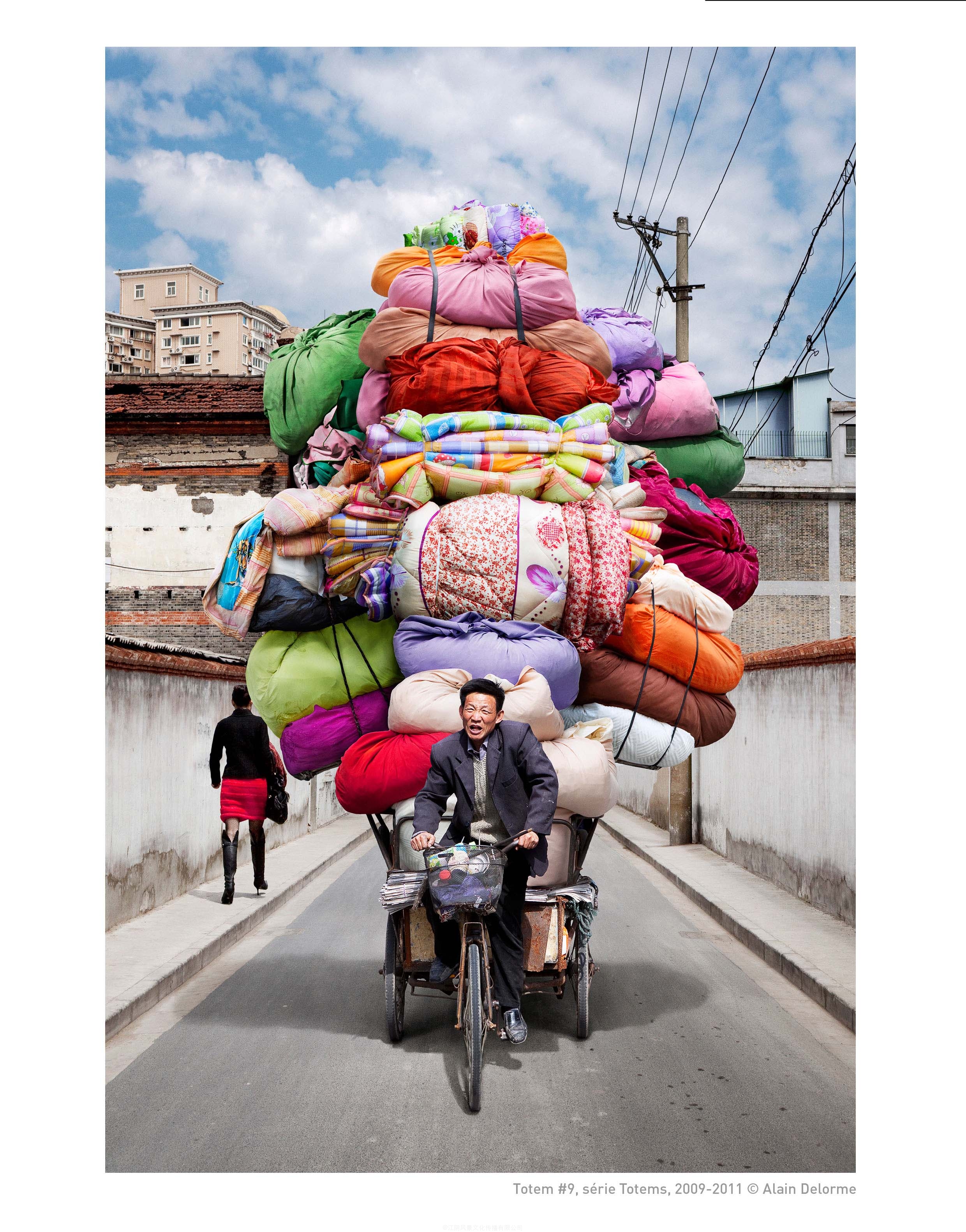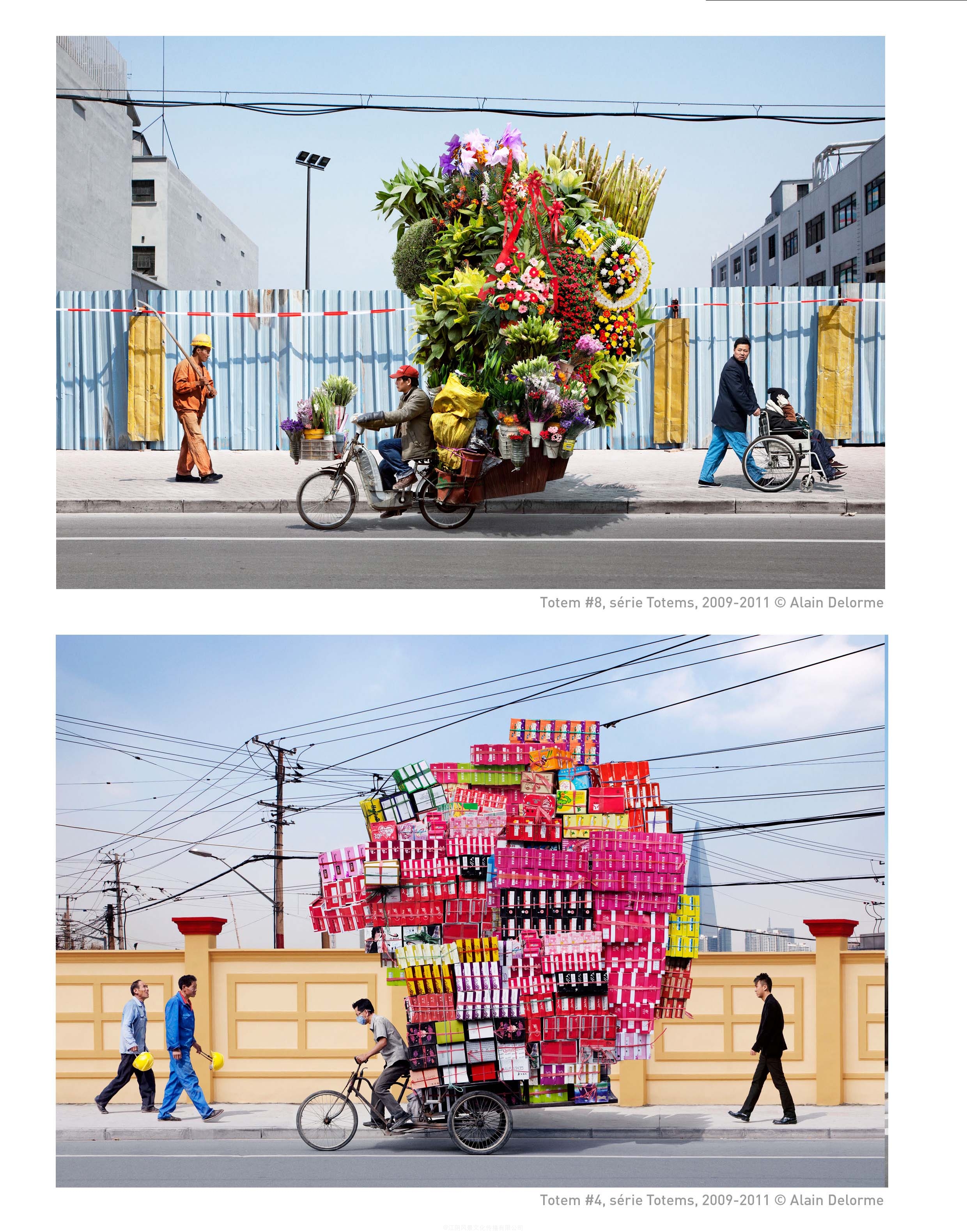Manufactured Totems 中国的负担
Manufactured Totems
Manufactured Totems
By Raphaële Bertho, photography historian, august 2010
The new Totems series by Alain Delorme plunges us into the core of contemporary China and its complexity. Under the blue sky of a highly colored Shanghai, men carry throughout the city unbelievable piles. These precarious columns made of cardboard or chairs appear as new totems of a society in complete transformation, both a factory for the world and a new El Dorado of the market economy.
Like Eugène Atget did in Paris at the turn of the century, Alain Delorme seems here to draw the portrait of the small workers in the Shanghai streets. While one is usually fascinated by the delusion of grandeur of Chinese society, Alain Delorme chooses to focus on the individuals running around the city. In terms of form, the author diverges from a documentary style and its affected neutrality, still adopting some frontality. The image is organized in horizontal strata, like in an archeological section. From the sidewalk to the building, the grounds are positioned at intervals and allow different urban temporalities to coexist: the everyday life, the ephemeral, the unceasing move of the passers-by, and the great transformations, building sites and new towers. Beyond the balance of these compositions, the author breaks the rules of the documentary genre, playing with the edit and the color to present us a type of “augmented reality”, bringing into light the paradoxes of the most dynamic city of China.
In these negatives, men perched on their bikes or pulling a cart carry tires, bundles, bottles… They are all different but have something in common: they cross the images as they cross the town, without ever settling in. These migrants coming from all over China are the heart of the new “world factory”. Required to fulfill all the chores, this “floating population” is the workforce of the Chinese miracle, the other side of the economic success of the Middle Kingdom. The author shows us the actors of a segregation altogether urban, social and economic. They seem misplaced in this sunny, bright-colored Shanghai. Alain Delorme turns upside down the order of the visible. These men become the heroes of this new world, whose force seems increased tenfold. We believe them able of all feats, maintaining the unpredictable balance of their bizarre burdens with dexterity.
Their loads indeed soar up dangerously towards the sky, ephemeral structures with instable balance. Like the new Realists, Alain Delorme shows subtly a part of reality and offers it a usually unnoticed meaning. These piles become sculptures, real works of art. Following the process of fetishization, they lose their functional value and gain a symbolical one. These objects, by nature reproducible and interchangeable, seem to acquire an almost sacred status. But what are these “Made in” products the totems of? Their role is ambiguous, as they smother as much as they make visible the workers of the big city. On one hand the man is almost swallowed by the objects, he is their fervent servant; he’s submerged by this multiplication of the same object. The manufactured objects become the pagan idols of consumer society. On the other hand, these temporary sculptures seem to turn upside down the established order, the individual differentiating this way in the gigantism of the urban world. Identifying himself with this elevation, man isn’t himself interchangeable anymore and becomes singular in this multitude.
The vertiginous height of the piles echoes the incessant expansion of the city itself. By updating the proposition of the Becher, Alain Delorme seems to create a parallel between these manufactured totems and the buildings in the background, which have become themselves contemporary sculptures. The urban space is permanently under construction, developing relentlessly. The skyscrapers invade the city and rise always higher, such as new totems, always more remarkable, always more impressing. Stratum by stratum, traditional China rubs shoulders with the contemporary industrial superpower. The race here is not only the one of the men in the city, but also the one of the city towards its future.
With a look of humor and poetry, Alain Delorme settles us in the heart of the new “Chinese dream”. Far from a hymn to materialism, these images, putting forward the overabundance of the objects, tend to the absurd and let catch a glimpse of the complexity of a country reinventing itself. Between dream and reality, these pictures turn upside down the scales of values and blur the border between the visible and the invisible.
制造图腾
由阿兰·德洛姆新的图腾系列掉价我们进入当代中国的核心和它的复杂性。高度有色上海蓝天下,男子携带的整个城市的令人难以置信的桩。这些岌岌可危列纸板或椅子出现彻底改造社会的新图腾,无论是世界的工厂和市场经济的一个新的黄金国。
像尤金Atget在巴黎,在世纪之交,阿兰·德洛姆似乎这里的小工人在上海街头绘制的肖像。虽然通常是着迷于中国社会的宏伟的妄想,阿兰·德洛姆选择把重点放在个人跑来跑去城市。在形式方面,笔者离开的纪录片风格及其影响的中立性,还采用了一些正面性。图像组织水平地层,就像在考古节。从人行道的建设,理由是定位的时间间隔,并允许不同的城市时间性共存:日常生活中,短暂的,不断移动的路人,和伟大的变革,建筑工地和新塔。除了这些组合物的平衡,打破了规则的纪录片流派,播放与编辑和色彩,呈现给我们一种类型的“增强现实” ,使中国最具活力的城市光悖论。
在这些底片,骑自行车,或栖息在拉一车的男子进行轮胎,捆绑,瓶子…他们都不同,但有共同的东西:它们交叉的图像,因为他们穿过小镇,从来没有安顿这些移民来自在中国新的“世界工厂”的心脏。须履行所有的家务,这个“流动人口”是中国奇迹的劳动力,中东王国的经济成就的另一侧。作者向我们展示了一个完全隔离的城市,社会和经济的演员。他们似乎在这个阳光明媚,鲜艳上海错位。阿兰·德洛姆变成可见的顺序颠倒。这些人成为了英雄这个全新的世界,其力量似乎增加了十倍。我们相信他们能够对所有的功勋,维护的灵巧他们离奇的负担,不可预知的平衡。
他们的负荷的确向天空,短暂的结构飙升危险与不稳定的平衡。新现实主义者一样,阿兰迪洛梅显示微妙的现实的一部分,它提供了一个通常被忽视的意义。这些桩成为雕塑,真正的艺术作品。拜物教的过程中,他们失去其功能价值,并获得一个象征性的。这些重复性和互换的性质,对象,似乎获得一个近乎神圣的地位。但什么是这些“制造”产品的图腾?它们的作用是不明确的,因为他们扼杀了,因为他们使可见的大城市的工人。一方面男人几乎吞噬的对象,他是他们的热切的仆人,他所淹没同一对象的这个乘法。所生产的对象成为消费社会的异教偶像。另一方面,这些临时的雕塑似乎倒置的既定秩序,个人鉴别这种方式在城市世界的巨人。找出自己与这个高度,男人是不是自己互换了,在这个众人变得奇异。
成堆的令人眩晕的高度,呼应了城市本身的不断膨胀。阿兰·德洛姆更新比彻的命题,似乎这些制造图腾的背景下,这已成为当代雕塑和建筑物之间创建一个并行。城市空间是永久开工建设,坚持不懈地发展。摩天大楼侵入城市,总是上涨比较高,比如新的图腾,总是更加出色,总是更令人印象深刻。通过地层的地层,中国传统的磨肩膀与当代工业超级大国。这里的比赛,不仅是在这个城市的男人之一,也是实现其未来的城市之一。
一脸的幽默和诗歌,阿兰·德洛姆解决我们在新的“中国梦”的心脏。远东从赞美诗到唯物主义,这些图像,提出了过多的对象,往往是荒谬的,让瞥见一个国家重塑自身的复杂性。梦想和现实之间,这些图片倒挂的价值的尺度,有形和无形之间的边界模糊。





